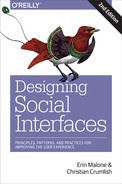Part III. Objects of My Desire
PEOPLE CONGREGATE AND PARTICIPATE on social sites and applications for reasons that are as varied and wide as the interests of all the people participating. Most people are drawn to an experience based on their particular interests, in hopes of learning more or meeting others like themselves. They can be looking for information, or they might have information to share. They have a passion—such as making handcrafted jewelry or taking landscape photographs—and at some point, they will want to share that with other people.
As a social experience designer, you should begin by defining the type of activity that you want to encourage in your space. Do you want people to collect or share? Are you interested in user contributions, such as comments or reviews, or curated information that you control? Or, do you want to create a framework around a specialized type of user-generated object that will then be the center of a social ecosystem, such as photos, or items for sale, or PowerPoint presentations?
Some of the earliest social networking sites to gain traction (SixDegrees, Friendster) ran into a “Now what?” wall. After a user had signed up, filled out a profile, found friends, and made connections, there wasn’t really much of anything to do there. The sites lacked a model of a social object, without which there are no activities besides trying to create a scale model of one’s own real-life social graph.
After you have a handle on the type of activity you want to foster and its associated subactivities, it is important to define the type of social object around which this activity will revolve. It will also be important to define who is responsible for providing the social object—the site or its users.
The term social object first appeared in a blog post by Jyri Engeström on April 13, 2005. Jyri, the cofounder of several social applications (later acquired by larger companies) and now an Entrepreneur in Residence at TrueVentures VC firm, wrote the following:
Social networks consist of people who are connected by a shared object. That’s why many sociologists, especially activity theorists, actor-network theorists and post-ANT people prefer to talk about “socio-material networks,” or just “activities” or “practices” (as I do) instead of social networks.... Flickr, for example, has turned photos into objects of sociality. On del.icio.us the objects are the URLs. EVDB, Upcoming.org (http://upcoming.org), and evnt focus on events as objects.
The concept has been further refined to encourage site builders to define the nouns and the verbs of the site, the verbs being what people do with the social objects around which the site is built. These can be “actions” such as play, read, view, share, collect, display, comment on, and annotate. You get the idea. Social is then further layered into the experience by making objects shareable, which we’ll cover in detail in Chapter 8.
JP Rangaswami posits this metaphor about social objects:
You can have a conversation without a social object. You cannot have a social object without a conversation. It is the conversation that makes the object “social.”
Conversations grow around social objects, much like pearls grow around microscopic dust. Social objects are about growth, they are “live.” If you try and “inject” a social object into a conversation, then what you get, at best, is a cultured pearl. That’s what mass media did. Mass media tried to farm conversations. And created cultured pearls. Social objects are natural, not artificial.
A successful social object is one that has layer upon layer of conversation created around it; as the number of participants increases, social objects enjoy network effects. Social objects are about participation and participants.
When designing your social interfaces, ask yourself what social objects belong in the architecture and how you are going to support them. What activities are you going to make possible that enable people to engage with one another around these social objects? The patterns in the next several chapters address activities and behaviors that revolve around a social object. We also introduce patterns that provide a framework for creating or delivering user-generated social objects.
